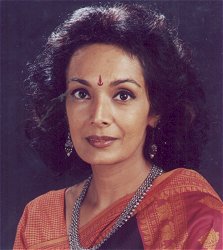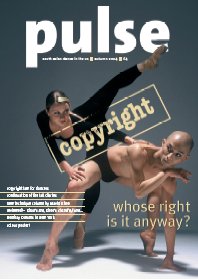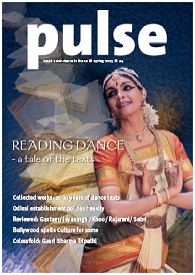
|
 |

|
 |
The Im-PULSE to Dance - Anita R Ratnam, Chennai e-mail: aratnam@vsnl.com May 18, 2005  At a time when media coverage for dance is evaporating around the world, PULSE is a strong reminder of the potent presence of the South Asian dance community in the UK. Editor Chitra Sundaram talks to Anita R Ratnam about the magazine that throbs with the energy of Indian dance. What is the genesis of PULSE? If one has to speak about its antecedents, then I would have to say that the newsletter ADITI would be the first publication on dance in 1993. That was the time that Indian (known as South Asian dance) was coming of age in the UK. One dramatic day in August of that year, more than one hundred dancers, in full costume, marched through the streets of London towards the Mayor's house and knocked on the door 'demanding to be let in!' The Mayor of London 'opened the doors' for Indian dance in one dramatic gesture. ADITI folded and the next publication was called EX-Tradition. PULSE, as you see it, started in 2000 as a quarterly and now it is 3 issues a year, each focusing on specific themes. What are the funding agencies that support PULSE? 85% of the budget comes from the London Arts Council who have just committed another three years of funding for PULSE. Subscriptions and advertisements are beginning to trickle in very slowly. PULSE is published by the South Asian organization called KADAM in Bedford, UK 

What are some of the topics and themes addressed in PULSE? Dance and Technology, Dance and Copyright, Dance Education, Modern Dance and Ancient Texts... Our audiences are dancers, funders, research students, scholars, dance presenters and libraries. It is also physically distributed or sold outside major performances (when Akram Khan dances) and conferences. We are on the 11th issue and our next issue will focus on dance costuming and 'aharya'. UK is being swept away by the Bollywood film craze. With so many specialized filmi dance schools in the country, is there any pressure to cover this genre in PUSLE? Or even to glamourize your issue with more colour? There is a great sweep of familiarity and excitement with Bollywood following the films like MONSOON WEDDING, BEND IT LIKE BECKHAM and the West End Musical BOMBAY DREAMS. Then Selfridges, the department store did the Indian Bollywood splash. Cherie Blair always wears an Indian shawl or scarf in public and so do many prominent British women. Today's Bollywood dance sequences are so energetic and physically demanding that many students of Bharatanatyam and Kathak in the UK are also performing filmi dances for festival and special shows without any conflict. Gone are the days when Sivaji Ganesan or Muthuraman gently did the twist on the dance floor with Saroja Devi. British media loves spectacle, high-octane energy and complicated moves of Bollywood choreography. Bollywood cinema has become a subject of study in universities. In the UK it is called "FILMI" dance not Bollywood. The movements have been broken down into "pet your dog", "change a light bulb", "put on roll-on deodorant" and other phrases to help teach filmi dancing to white Britishers! There is a small interactive screen inside Madame Tussauds teaching visitors how perform filmi dances! (Personally I think Vijay in TIRUPAACHI is a terrific dancer and the choreography in that film is spectacular). Having become a specialized dance form by itself, I would cover filmi dancing to grab the younger reader and also to commission writers like Richard Turner to comment on the significance of the trend. What are the biggest challenges to each issue of PULSE? Getting writers to take responsibility for their words. Finding new writers and reviewers who are succinct and who understand dance objectively as well as subjectively. I want to print the writers' photos in each issue so that they become more than a byline. PULSE recognizes that South Asian dance is a cultural product as well as an art form and so it takes an effort to understand it beyond mere movement and choreography. I wish to discuss the form as a cultural product beyond invoking Gods, myths, storytelling and religion. With the western idea of the separation of art and religion, it has become more important for the magazine to take notice of the form as an independent genre beyond its social and cultural roots. Addressing the critics in Britain and inviting them to apply their own aesthetic when watching or reviewing our dances. PULSE keeps the connections with academia, dancers, critics, funders and presenters to understand what is happening to the dance beyond mere historical and anthropological reference points. What about the sweep of popularity of contemporary South Asian dance in the UK at the expense of classical dance? There is a growing audience for contemporary dance and declining numbers for classical dances. Visiting masters of the classical tradition from India attract audiences but they are largely those who are already familiar with the form. Today stars like Akram Khan, who burst onto the dance scene as a contemporary dancer, is able to sell out 7 nights at the Queen Elizabeth Hall for his classical Kathak shows. His contemporary dance audiences will follow him anywhere because of his talent. But these crossovers are rare. Today even classical dance performers have to maintain the contemporary aesthetic - good lighting, costuming, stagecraft, elegant and not in-your-face theatrics - these have become a must no matter what the dance style. How has your background - Bharatanatyam, IIM- Ahmedabad and the corporate world-influenced PULSE? I want to bring a greater accountability all around. I have insisted that every photograph in the magazine carries the name of the photographer. Avinash Pasricha, the famous dance photographer in Delhi, was so touched by this consistent mention. I would like to also publish and publicize who has received grant monies for what project. This way we can begin to self account and self manage our careers. But this is going to be very difficult. I would also like to list the "WHO's WHO" of the South Asian dance world in the UK. Other dance publications like DANCE VIEW and DANCE INK in the US have either folded or gone on the Internet. SRUTI in India is not exactly thriving. Space for dance has either disappeared or has shrunk considerably. Any views on an on-line version of PULSE? I think that there is a great value to something that can be held, read and re-read - a magazine that stands on the shelf and on your table. We spend a lot of time and energy in the design of the magazine. We want the magazine to be smart and pleasing to look at and engaging to read. With the promise of funding for another three years, I feel confident that this print 'avatar' is here to stay. You can contact the editor at editor@pulse.org |